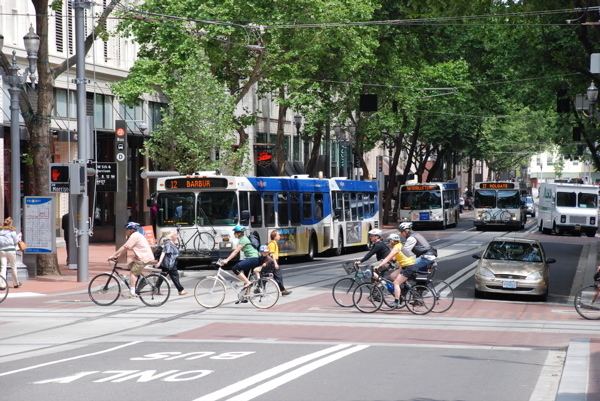 | ||
A transit mall is a street, or set of streets, in a city or town along which automobile traffic is prohibited or greatly restricted and only public transit vehicles, bicycles, and pedestrians are permitted.
Contents
Transit malls are instituted by communities who feel that it is desirable to have areas not dominated by the automobile, or as a way to speed travel time through an area—usually the city center—for transit vehicles and as a transport hub for interchanges, making them more efficient and thereby more attractive as an alternative to car use. Converting a street or an area to a transit mall can be a form of pedestrianization, allowing pedestrians and cyclists as well as transit vehicles to move more freely, unimpeded by private motor traffic, if autos are banned completely. However, some transit malls are not auto-free, but rather restrict cars and other private traffic to only short segments or only one lane, with other lanes being limited to buses or trams (streetcars).
Europe
A number of European towns and cities have made part or all of areas their car-free while permitting public transit vehicles. These are often accompanied by car parks on the edge of the area and/or park-and-ride schemes. Most of these zones allow delivery trucks to service the businesses located there during the early morning, and street-cleaning vehicles will usually go through these streets after most shops have closed for the night.
Examples include:
North America
In North America, the creation of pedestrian-friendly urban environments is still in its infancy, but transit malls have existed in a few cities for more than 40 years, starting with the Nicollet Mall in Minneapolis, Minnesota in 1968, followed by the Granville Mall in Vancouver, British Columbia, in 1974 and the Portland Mall in 1977. In North America, transit malls usually take the form of single streets in which automobiles are mostly prohibited but transit vehicles are allowed. They are rarely completely free of motor vehicles. Often, all of the cross streets are open to motorized traffic, and in some cases taxis are allowed and truck deliveries are made by night.
Examples include:
Australia
Examples include:
Asia
Examples include:
